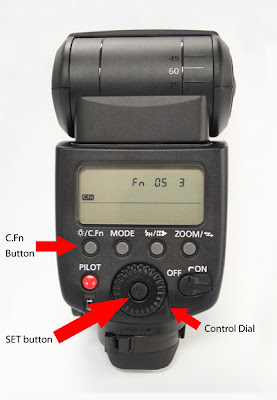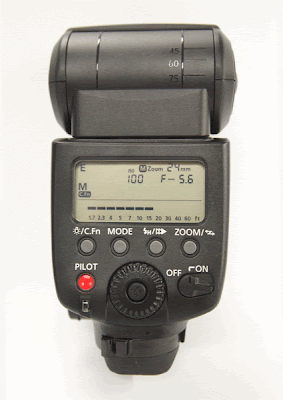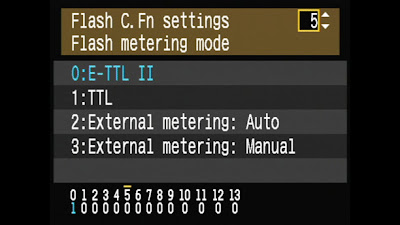..
..
Speedlite 580EX II's External Automatic Flash Exposure Sensor And Your EOS Camera
Canon’s latest high-end Speedlite 580 EX II has a couple of features long requested by serious amateurs and professionals. One of these is an external automatic flash exposure sensor, which provides the option of automatic flash – but not TTL (Through The Lens). Instead, the flash controls its output similar to older “thyristor” flash units many pros used in years past.
..
 The Speedlite 580EX II now has an external automatic flash exposure sensor - a great option for different types of shooting
The Speedlite 580EX II now has an external automatic flash exposure sensor - a great option for different types of shooting..
Far from being a throw-back to the good old days, this is a viable option for different types of shooting. One example is providing automatic exposure when a flash is positioned off-camera, especially if it’s triggered by a third-party radio or infrared remote system. Likewise, it will provide automatic flash when triggered by conventional flash slave. Additionally, some users may find that it provides less fussy and more consistent flash exposures for ordinary on-camera flash with indoor scenes where you aren’t trying to balance flash and ambient light.
..
Traditional non-TTL automatic flash:
Traditional non-TTL automatic flash:
The Canon Speedlite 580EX II can perform this with any EOS camera, film or digital. We’ll explain how to set the speedlite to this mode in a moment. With yesterday’s “thyristor” type auto flashes, the photographer would dial-in his or her ISO setting on the flash unit, and in some cases, would also choose one of a few available distance range settings (for instance, the popular Vivitar 283 flashes had a red color-coded range, good from about 3 to 30 feet for direct flash). A little scale told the photographer where to set the lens aperture when the flash was set to a particular distance range. The flash would vary its output by literally using its front-facing sensor to read reflected flash illumination as it returned from the subject. When the sensor “thought” enough light had returned, it instantly sent a stop signal to the flash. The result was brief flash durations when close to a subject, and longer, brighter durations when shooting something farther away.
..
This type of automatic flash has worked for many photographers for several decades. While there is no question a modern TTL flash and camera can combine to perform tasks simply not possible using an external flash sensor (like automatically balancing ambient and flash exposure), auto flash using an external sensor is a proven method of flash exposure control. The Speedlite 580EX II now gives users this option.
..
Setting external auto flash with the 580EX II using the EOS-1D Mark III:
Setting external auto flash with the 580EX II using the EOS-1D Mark III:
This can seem tricky, since simply pressing the flash unit’s Mode button will not call up the external flash options. To do this, you must activate the 580EX II’s flash custom functions. With the EOS-1D Mark III camera, this is easy – you can do it from the camera’s Menu (2nd Set-up Menu > External Speedlite Control > Flash C.Fn settings > 3: External metering: Manual.). Don’t be fooled by the wording on the Mark III’s menu; this is still automatic exposure flash, using the flash’s external metering sensor. It’s not manual flash exposure – that’s done with the flash’s Manual mode!
... .. ..
.. ..
(Simulated Displays) Follow these three easy steps to set External Auto Flash on the Speedlite 580EX II while using an EOS-1D Mark III
....
....
Setting external auto flash on the 580EX II with other EOS cameras:
..
1. Press the illumination/C.Fn button on the back of the 580EX II for at least two seconds until the speedlite’s display changes.
..2. Turn the flash unit’s control dial until “Fn 05” (speedlite Custom Function 5) appears.
..3. Press the speedlite’s SET button to make the second digit blink on and off; while it is blinking, turn the control dial on the flash unit until option 3 appears (Fn 05-3). By doing this, you have now set the flash to perform standard, traditional external flash metering. This can be done with any EOS SLR, film or digital.
.. ..
..Using the standard External Metering -- Manual mode:
in spite of “Manual” appearing in the wording, this mode does indeed provide automatic flash exposure, using the 580EX II’s external flash sensor. “Manual” means that most communication between flash and camera no longer takes place, and the user must make the settings detailed below.Once set, a letter “E” appears in the upper-left corner of the flash’s LCD panel (if “E-TTL” still appears, you didn’t set external automatic flash control...try again). You’ll also see an ISO indication, and the aperture (“F-5.6” or whatever aperture number the flash is currently expecting). Below this is a distance range scale, in either feet or meters (change it to feet with flash Custom Function 0-1).
..
..
 A letter "E" appears in the upper left corner of the LCD display when setting the Speedlite 580EX II to External Metering: Manual Flash Mode
A letter "E" appears in the upper left corner of the LCD display when setting the Speedlite 580EX II to External Metering: Manual Flash Mode..
Like traditional auto flashes, when the 580EX is set to the External Metering: Manual, the flash has almost no communication with the camera body. The only exception is that you’ll still get a ready light in the finder, and the auto zooming of the flash head to match the lens in use still functions with EOS digital SLRs.
Like traditional auto flashes, when the 580EX is set to the External Metering: Manual, the flash has almost no communication with the camera body. The only exception is that you’ll still get a ready light in the finder, and the auto zooming of the flash head to match the lens in use still functions with EOS digital SLRs.
..
The photographer must set the following manually:
a) ISO on the speedlite
b) Aperture on the speedlite’s LCD display
..
Once these are set by the user to match the camera’s settings, the flash’s distance scale will update to show you the distance range you can shoot with automatic flash control. The flash’s zoom head will adjust automatically to match the focal length of the lens in use. The camera should be set to its Manual exposure mode in most circumstances. Since the flash and camera are not working in tandem to control overall exposure automatically, it is risky to set Av mode and hope to properly expose the ambient light along with flash illumination. Generally, a fast sync speed like 1/200th or 1/250th of a second is used; it is impossible to set faster shutter speeds if the speedlite is on. Hi-speed flash sync mode will not operate in external automatic flash mode. Ignore the camera’s analog metering scale in the viewfinder – it is reporting how your current settings would expose ambient light, not flash.
.. Manual mode on the EOS-1D Mark III is the primary choice for non-TTL auto flash, using the speedlite’s external sensor
Manual mode on the EOS-1D Mark III is the primary choice for non-TTL auto flash, using the speedlite’s external sensor..
Other EOS camera settings to consider:
Do not use the P-mode or Tv mode, since these set aperture automatically, and the flash has no way of knowing what aperture the camera is using.The External metering: Manual mode is the only type of external sensor auto flash that will work if the Speedlite 580EX II is used off-camera, and triggered with either a PC cord or a non-dedicated type of remote controller or standard photo slave unit.
..
Deliberately under- or over-exposing flash in External metering:
Deliberately under- or over-exposing flash in External metering:
Manual modeIf you want flash exposure to intentionally be greater or less, you have to do one of two things: set a different camera lens aperture than the one you’ve set on the back of the flash, or change the camera’s ISO to a different value than the one you reported to the speedlite.In other words, if you take a picture with all flash settings matching the camera settings, and the first shot looks too dark, you can brighten flash exposure by:1) Setting a wider lens aperture than what you set on the flash (example: flash says f/8; you set the camera to f/5.6 to brighten exposure one stop).2) Raise the camera’s actual ISO above what you’ve set on the flash (again, to lighten the exposure, if the flash’s LCD panel is set to ISO 100, setting the camera’s ISO to 250 would deliberately over-expose by 1-1/3 stops).
..
EOS-1D Mark III and the Speedlite 580EX II:
EOS-1D Mark III and the Speedlite 580EX II:
The newest Canon EOS digital SLRs* add another method of using the external flash sensor on the 580EX II. In this instance, the flash and camera do communicate extensively, so the aperture and ISO you set on-camera are immediately relayed to the speedlite. Automatic flash is still controlled by the flash’s external sensor; the user still sets shutter speed and aperture (as well as ISO) – on the camera body only. Manual mode on the camera is again ideal; theoretically, the aperture-priority Av mode can be used, but there’s the risk of problems with exposure balance as well as shutter speeds that are too slow for safe hand-holding when indoors.
.
..
 (Simulated Display) EOS-1D Mark III menu navigation C.Fn 05-2 allows a user to set external metering for Automatic External Flash
(Simulated Display) EOS-1D Mark III menu navigation C.Fn 05-2 allows a user to set external metering for Automatic External Flash..
Using the EOS-1D Mark III, this is the 580EX’s Custom Function 05-2 – External metering: Auto. In this case, “Auto” means that the camera can communicate its settings directly to the speedlite as you set them. Once set (you can also use the camera’s External Speedlite Control menu to set flash C.Fn 05-2), the ISO read-out disappears from the 580EX II’s LCD panel (it’s always the same as that on the camera).
... (Simulated display: Manual Mode) When setting the Speedlite 580EX II to External Metering: Auto mode, the ISO read-out disapears and is not accessible
(Simulated display: Manual Mode) When setting the Speedlite 580EX II to External Metering: Auto mode, the ISO read-out disapears and is not accessible..
Unlike the External metering:
Manual setting, the Auto option with the Mark III does allow you to use the P-mode or Tv mode on the camera. Automatically-set apertures in these modes are instantly communicated to the speedlite. This only happens, however, if the flash is either mounted on the camera, or attached via the optional Canon Off-Camera Shoe Cord. With External metering: Auto, the distance display is updated in real time as you change ISO or aperture on the camera. One fundamental difference, though is that you cannot intentionally over-expose or under-expose flash by simply changing aperture. Unlike with the “External metering: Manual” option, as you change apertures, speedlite power adjusts to keep flash exposure constant. Opening up the lens aperture means you increase the possible maximum distance you can shoot out to, but does not simply lighten the overall flash exposure. Instead, you must use Flash Exposure Compensation (either on the camera body, or at the speedlite). The procedure is the same as if you were using E-TTL and applying Flash Exposure Compensation.
..One other note:
Neither type of external sensor auto flash can be used in Canon’s Wireless E-TTL mode. As soon as you set a 580EX II into either “slave” or “master” settings, the External Auto setting immediately reverts back to E-TTL on the flash’s LCD panel. External sensor auto is impossible to set.
..
(* EOS-1D Mark III only, as of July, 2007)
..
Switching back to E-TTL:
Switching back to E-TTL:
Once External flash metering has been set with the 580EX II’s flash Custom Function 05-2 or 05-3, to revert back to E-TTL, you cannot just push the flash’s mode button. Instead, you must re-set Flash Custom Function 05 to option “0” (E-TTL II). Do not set the “TTL” option with digital SLRs. With the EOS-1D Mark III, you can again do this using the camera’s menu, under External Speedlite Control. With other EOS digital SLRs, you must engage the flash’s Custom Functions via the speedlite’s C.Fn button, navigate to Fn 05, and set it to “Fn 05-0” on the speedlite’s LCD panel.
..
+To+change+from+External+Sensor+auto+back+to+E-TTL,+user+must+set+Flash+Custom+Function+05+back+to+%27%270%27%27.jpg) (Simulated Display) To change from External Sensor auto back to E-TTL, user must set Flash Custom Function 05 back to "0"
(Simulated Display) To change from External Sensor auto back to E-TTL, user must set Flash Custom Function 05 back to "0"The External flash sensor:
One thing for experienced users to keep in mind is that the external sensor on the 580EX II measures a relatively narrow 20-degree angle of view. This never changes, regardless of the lens that’s on the camera (a fundamental advantage of TTL flash metering). The 20-degree view means the flash measures an area that’s about the same as that covered by a 135mm lens (on a full-frame camera). This may be a “tighter” metering area than what users may be accustomed to with previous-generation “thyristor” flash units. Keep this in mind when evaluating flash exposures in external sensor mode.
..
Summary:
Summary:
The external automatic sensor option with the 580EX II flash is one that many photographers will want to experiment with, at least from time to time. It will certainly prove useful in some circumstances, such as removing a flash from the camera to light up backgrounds or other subjects from an angle. And some users may find they prefer its exposure characteristics in general to those of E-TTL in ordinary indoor candid situations. E-TTL is still going to be vastly preferable for balanced-fill flash outdoors, or for balancing ambient light and flash indoors in Av and Tv modes. And the external sensor auto mode, as discussed previously, will not work at all with Canon’s Wireless E-TTL flash system. Whether you own the latest EOS cameras or not, external sensor auto flash is easy to experiment with using the 580EX II speedlite, and adds a new versatility that EOS users have requested for some time.
..
..
..
..


































